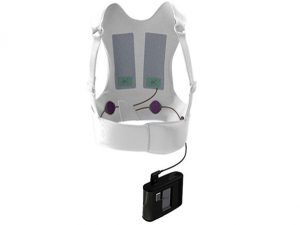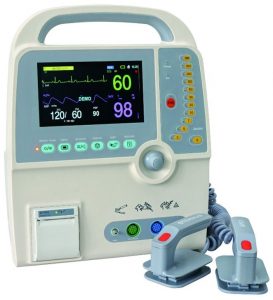Defibrillators and Their Types
Defibrillators are essential tools used by medical professionals for restarting a patient’s heart. It is a device that works by providing an electric shock to the heart so that the patient’s heart comes out of a lethal irregular heart rhythm, also called ventricular fibrillation or arrhythmia or ventricular tachycardia. In simple words, defibrillators help in restoring your regular heartbeat.
Defibrillators, when used along with CPR and other special medical care, help in saving lives. But defibrillators do not help in treating the underlying causes and even does not work in the case of some severe and untreated cardiac diseases.
Types of Defibrillators
There are five different defibrillators, and they are all designed to function in different ways and under varied conditions.
- Automated External Defibrillators
 These are the types of defibrillators that use an electric pulse to treat cardiac attack during the initial few minutes of arrhythmia. When it is strapped, its electrode pads will start detecting the irregularities like ventricular fibrillation and ventricular tachycardia, and on detection, it provides shock to restore the pulse of the patient.
These are the types of defibrillators that use an electric pulse to treat cardiac attack during the initial few minutes of arrhythmia. When it is strapped, its electrode pads will start detecting the irregularities like ventricular fibrillation and ventricular tachycardia, and on detection, it provides shock to restore the pulse of the patient.
- Implantable Cardioverter Defibrillators
 These are the medical devices that surgeons mostly implant in their patient’s bodies under their collarbones. Here thin wires are connected to the heart, and the battery-powered device sends an electric shock to the core when it detects any irregular heartbeat. The main benefit of using an ICD (Implantable cardioverter defibrillators) is getting consistent protection from heartbeat irregularities, even when the patients are outside the hospital.
These are the medical devices that surgeons mostly implant in their patient’s bodies under their collarbones. Here thin wires are connected to the heart, and the battery-powered device sends an electric shock to the core when it detects any irregular heartbeat. The main benefit of using an ICD (Implantable cardioverter defibrillators) is getting consistent protection from heartbeat irregularities, even when the patients are outside the hospital.
3. Wearable Cardioverter Defibrillators
 These defibrillation devices are used as vests by the patients under their clothes. Patients require them at risk of dying because of arrhythmia. Sensors present in WCD (Wearable cardioverter defibrillators) help in detecting ventricular arrhythmia and then provide shocks for treatment and restoration of the patient’s heartbeat. WCDs are entirely automatic, and they do not need any involvement from a medical professional for the deliverance of shock.
These defibrillation devices are used as vests by the patients under their clothes. Patients require them at risk of dying because of arrhythmia. Sensors present in WCD (Wearable cardioverter defibrillators) help in detecting ventricular arrhythmia and then provide shocks for treatment and restoration of the patient’s heartbeat. WCDs are entirely automatic, and they do not need any involvement from a medical professional for the deliverance of shock.
4. Advanced Life Support Defibrillators
 These are heavy-duty resuscitating devices that many paramedics and medical professionals make use of. For example, many ambulances contain ALS defibrillators for monitoring and restoring the person’s heartbeat while traveling to the hospital. It also can monitor blood pressure, levels of carbon monoxide, and other such relevant information. Advanced life support defibrillators help stabilize a patient and enhance their chance of survival until they reach a hospital.
These are heavy-duty resuscitating devices that many paramedics and medical professionals make use of. For example, many ambulances contain ALS defibrillators for monitoring and restoring the person’s heartbeat while traveling to the hospital. It also can monitor blood pressure, levels of carbon monoxide, and other such relevant information. Advanced life support defibrillators help stabilize a patient and enhance their chance of survival until they reach a hospital.
5. Manual External Defibrillators
 Manual external defibrillators are mainly used by technicians having exclusive medical training. The user must choose the specific shock frequency and then provide shock at their selected time. The defibrillator cannot detect the irregularities in the patient’s heartbeat and choose the voltage. It is entirely manual and does not depend on any automatic features. They remain connected to the electrocardiogram, a machine that helps depict heart activity to all medical professionals.
Manual external defibrillators are mainly used by technicians having exclusive medical training. The user must choose the specific shock frequency and then provide shock at their selected time. The defibrillator cannot detect the irregularities in the patient’s heartbeat and choose the voltage. It is entirely manual and does not depend on any automatic features. They remain connected to the electrocardiogram, a machine that helps depict heart activity to all medical professionals.
Conclusion
Although each defibrillator functions differently, they all have one common aim regulating their patient’s heartbeat. They regenerate the heart’s capability to pump blood. But as we know that each of them is designed for some specific situations. Therefore, it is vital to know which kind of defibrillators should be used to save lives.
At MediHouse, we have a range of Defibrillators of high quality and durability.
Contact us for booking orders and home deliveries
Phone Number – 9400630000
Whatsapp – 9447771361
Email – MediTvm@gmail.com




